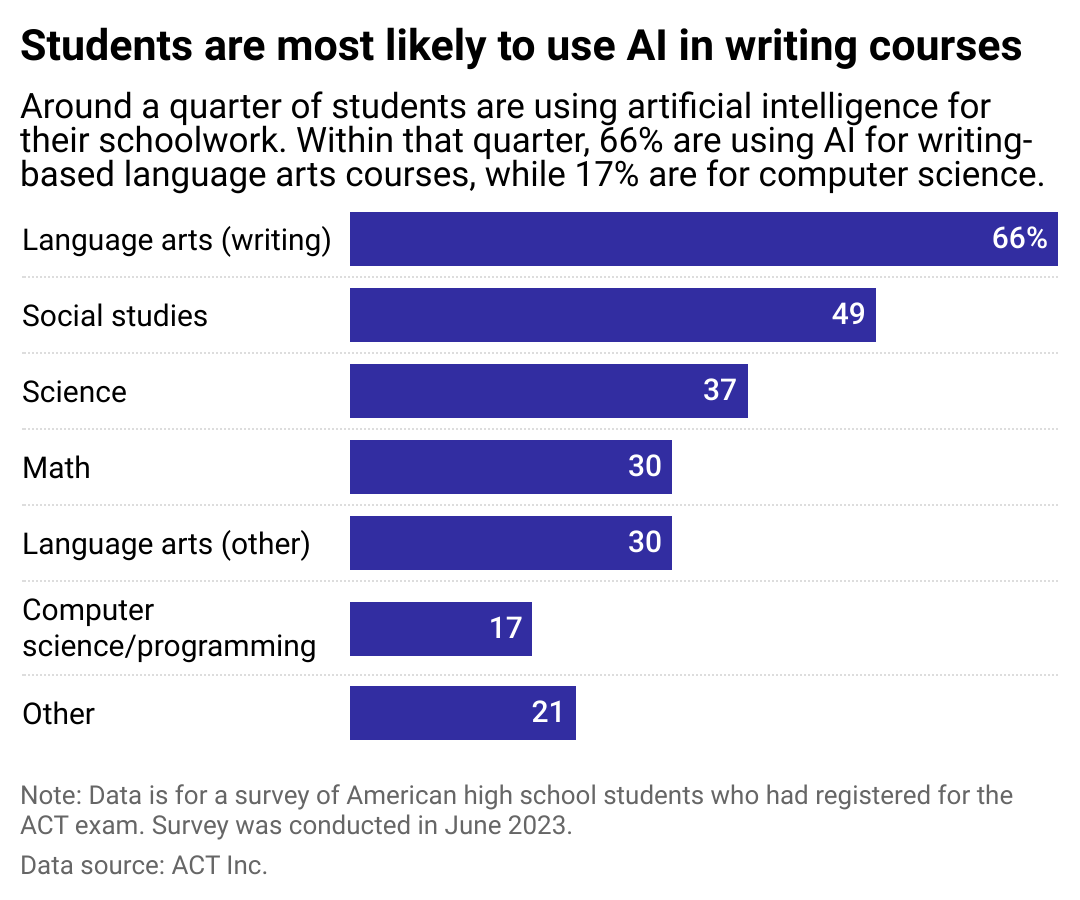How many high school and college students are using AI tools?

picture alliance // Getty Images
How many high school and college students are using AI tools?
A closeup of student’s hands typing on the computer keyboard.
Since the public launch of Open AI’s ChatGPT in November 2022, artificial intelligence tools have become widely used by the general public. But one group was particularly quick to embrace the burgeoning technology: teenagers.
According to a December 2023 report by ACT Inc., the creator and administrator of the standardized test for college-bound students, nearly half of the surveyed high school students (46%) reported using AI tools, especially ChatGPT, to help them with their studies.
These generative AI tools—which rely on machine learning and neural network technology—can write code, generate images, and create content that appears convincingly human-produced. They can also recognize patterns in data and learn from new information they encounter, enabling them to perform tasks like writing poems and stories and solving word problems.
These tools have also taken on the function of learning aids, helping students as virtual tutors by summarizing and explaining complex topics and answering complex questions almost instantly. Generative AI tools also help students by serving as a writing clinic, assisting users with brainstorming ideas and structure for essays, papers, and school projects.
Using survey data from the ACT and other sources, Numerade looked at how many students use AI to help them with their studies.
![]()

Numerade
AI is relatively popular in writing-based courses
A chart showing how many students are using AI for their work in high school. AI is most common in writing-based language arts courses and social studies and less common in math and computer science.
Approximately 74% of the students surveyed believed that taking advantage of artificial intelligence would boost their performance in school assignments.
According to the ACT survey, ChatGPT was the most common AI tool used by students, with 83% of students using AI for schoolwork reporting that they use ChatGPT, followed by Dall-E 2 and Bing Chat.
Language arts was the most common course in which students used AI tools, the ACT report found. AI tools for such courses take advantage of the technology’s strengths, especially when it concerns fiction, where the focus is on creativity and structure over factual accuracy.
The ACT report also found an association between academic achievement and the use of AI. Students with higher ACT scores tended to utilize AI tools to help themselves with schoolwork more than their classmates with lower scores.
At the college level, more than half of the students surveyed by Tyton Partners in a study commissioned by Turnitin reported using generative AI for schoolwork. However, only 22% of faculty members surveyed reported using AI tools.

Canva
How will AI affect students in the long run?
A group of students in a classroom looking at the computer screen.
Despite the widespread adoption of artificial intelligence by students, concerns over AI tools’ accuracy and their effect on learning remain.
According to the ACT, 64% of the students who said they did not use AI for assignments reported that they did not trust the tools enough. Among the surveyed students who use AI tools for schoolwork, 63% reported that the content produced by AI tools had inaccuracies.
The use of AI tools poses the risk of making students dependent on them. This could be a problem, especially when AI tools are used to generate arguments and literature reviews. Extreme reliance on these tools often introduces the machine’s biases into academic work while disincentivizing students from contributing original perspectives. What’s more, the fact that AI tools produce content based on the vast body of content they’ve been trained on with insufficient attribution makes one using them run the risk of accidental plagiarism.
Despite these concerns, many students (62%) and instructors (58%), believe that, in the long run, the use of AI in learning will have positive outcomes in education rather than negative consequences, according to a report from textbook publisher McGraw Hill.
Story editing by Elena Cox. Copy editing by Tim Bruns.
This story originally appeared on Numerade and was produced and
distributed in partnership with Stacker Studio.





